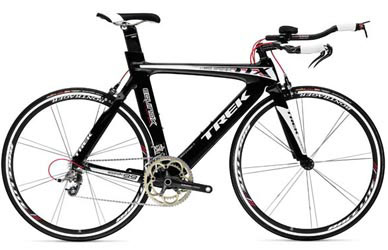

Multimedia
Check out the parts of this bike
Links
Treknology
Pushing the limits of bipedal research
Thousands of white plastic bags cover the converted dining room’s stained red carpet, each containing a conglomerate of energy bars, sunscreen and body lubricant. As Joe Palac enters the room, ready to add his bag to the mass, a smile spreads across his face. At the back of the room, neatly written in blue on a dingy white board is the simple message, “Yes, this is the ‘get fully naked’ room.” The sign’s humor is a welcome break for Palac, who, for the last 30 minutes, has been engulfed in the pensive atmosphere of the Ironman race check-in.
Like the sign, Palac is an anomaly in this race. His 6’2”, 247-pound frame stands out from other competitors like Gulliver among the Lilliputians. Triathletes refer to athletes like him as Clydesdales, though Palac possesses none of the grace of the Budweiser-toting namesake. His apartment’s bookshelves are lined with titles like “The Triathlete’s Training Bible” and “Advanced Sports Nutrition,” but Palac ignores the rhetoric, opting for a pre-race dinner of steak and Bud Light. “If the course was all downhill,” Palac jokes, “I’d probably win.”
Despite these perceived shortcomings, envious eyes follow him throughout check-in, gazing at the object guided by his right hand. The item of their admiration is the one crucial element Palac has in common with the world’s top triathletes – his Trek bike.
Conceived by accountant Richard Burke and bike-store owner Bevel Hogg in 1975, Trek’s Waterloo, Wis., campus has matured into one of the biking industry’s premier think tanks. Although Burke’s entrepreneurial savvy helped the company grow, it is Trek’s willingness to adapt new technology that has kept it at the forefront of bike design. From pioneering aluminum bonding frames in the 1980s to their early work with carbon fiber in the 1990s, its bikes have always echoed the newest scientific innovations.
This continual effort to progress the world of biking ultimately led to the creation of the Advanced Concept Group. Described by Trek as their corporate rocket scientists, the ACG is a conglomerate of biking enthusiasts whose sole objective is to push the limits of the sport into realms bordering on science fiction.
“What we do is to come up with the bikes that you will see in the dealer showroom two years from now, up until 10 years from now,” says ACG senior composite design engineer Doug Cusack.
This cutting edge position offers ACG employees virtually boundless creative freedom, while challenging them to find practical, cost-efficient mediums to bring their theoretical ideas to consumers. For Trek, addressing these abstract problems begins with hiring innovative employees whose creative potential could change cycling.
Research and development mechanical engineer Damon Rinard exemplifies this ingenuity. Before joining the ACG, Rinard worked at Cycle Composites, the parent company of Kestrel Bikes. There he worked with carbon fiber, a rigid, lightweight material composed of thin carbon strands bonded together. Rinard used this experience to construct a carbon fiber bike in his garage, while simultaneously maintaining a website detailing his progress. The website made him a cult hero of sorts, eventually garnering enough attention to entice Trek. After graduation, Rinard accepted a position with the company.
Home I Mind I Body I Soul I Site Map
About Us I Contact Us I Business Partners I Archives
Copyright 2008 Curb Magazine